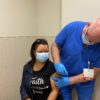Human Trafficking – Why You Should Stay Tuned Into Your Teens & Tweens
January is National Human Trafficking Awareness and Prevention Month. Since 2010, this month has been declared a time to raise awareness and educate everyone on how they can prevent and respond to human trafficking. Anyone can experience human trafficking but those who have been historically, underserved or marginalized, including people of color, LGBTQIA+ folk, and women and girls are especially vulnerable. But what is it? How do you know if you or someone you love are at-risk or have been trafficked?
Human trafficking vs. Labor trafficking
Human trafficking is a business that is built on stealing someone’s freedom for profit. There are two main types – sex and labor trafficking. In the first case, traffickers defraud, trick, and physically force someone into providing commercial sex where anything of value is exchanged. In some cases, that may be money; in others food, clothing, or a place to sleep. For minor victims, this is considered a form of child abuse and does not require proof of force, fraud, or coercion.
With labor trafficking, victims are lied to, assaulted, manipulated, or threatened into working under conditions that are inhumane or otherwise unacceptable. Human trafficking is hidden in plain sight in our communities and neighborhoods impacting thousands to hundreds of thousands of people every year. Perpetrators can be anyone – individuals, business owners, gang members, restaurant owners, farmers, government representatives, boyfriends/girlfriends/spouses, and even parents. These predators lure victims through promises of protection, love, adventure, home, or opportunities.
Grooming
Trafficking begins with grooming where a friendship or emotional connection is made for the purpose of exploiting that connection. Grooming is what makes it possible for the trafficker to manipulate a child or teenager into cooperating with them. It also makes it hard for the victim to disclose what is happening to them. Depending on the child, this process can be very fast. The new person identifies the child’s vulnerabilities and needs and responds to them with gifts, support, and even promises of love.
Traffickers isolate their victims from friends and family in order to control the situation without interference. Increasingly, children and teens are trafficked online. Tweens and teens are recruited through video games, social media, and other online platforms. This has picked up even more during the Covid-19 pandemic where our children are spending more time online. The child thinks they are making virtual friends when, in fact, they are being groomed by a trafficker.
Build healthy parental attachments
Think about your relationship with your child. It changes and evolves over time. As they get older, you stop making play dates for them and allow them to choose their own friends. This is to be expected, but as they age you have to continue to build and maintain healthy relationships with them.
Many victims are vulnerable because they feel depressed, lonely, isolated. Healthy parental attachments help to reduce those vulnerabilities. Look for signs of withdrawal, anxiety, or depression, sudden changes in grades, changes in engagement in school, new friends or controlling relationships, for example. Talk to them about what is going on. Listen to them without judgement and let them know you are open to hear whatever they may have to say to you.
Talk to your children early and often about healthy relationships and healthy sexual development. Use resources like www.Amaze.org for age-appropriate and helpful information. If you are not comfortable having these conversations, turn to a trusted health care provider, counselor, or therapist.
Online habits
Stay on top of their online habits. Traffickers are on the internet everywhere your child may be. Know what your child is doing and what is OK or not OK to post, who they can or should chat with, and who to block. Turn off location services when posting on social media and definitely don’t post pictures that show their school or neighborhood. If they do befriend a trafficker, we don’t want to make it easy for that person to find them and lure them in person.
Lastly, if you are concerned that your child is being trafficked, contact the Human Trafficking Hotline. They can provide information to assist you as well as help you to get your child out of the situation. Call them at 888-373-7888 or text HELP or INFO to 233733.
P.S. Check out additional resources at https://www.ssw.umaryland.edu/pari/resources/
______________
Bio: Nadine Finigan-Carr, PhD, affectionately called “Dr Nay,” is a mom, scholar, and trained yoga instructor. Her research focuses on preventing risk behaviors in children and adolescents so that they can thrive. She is the author of Linking Health and Education for African American Students’ Success (Routledge Press). For more information see her website www.nadinefinigancarr.com








Leave a Reply